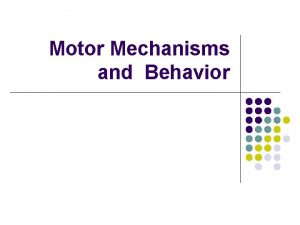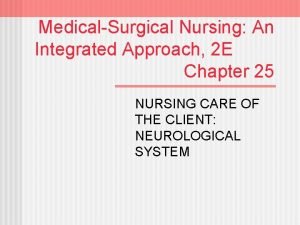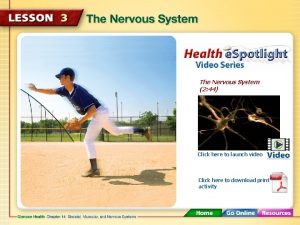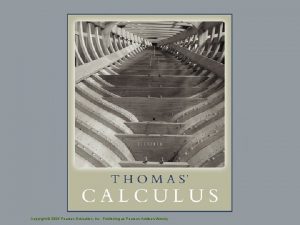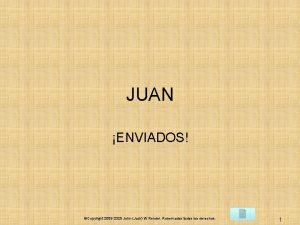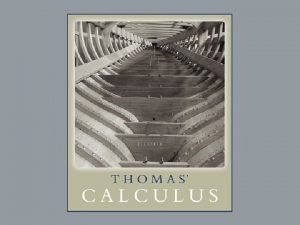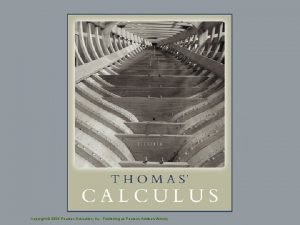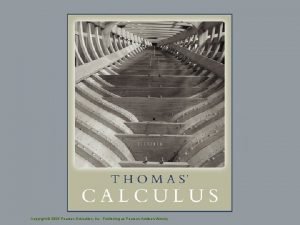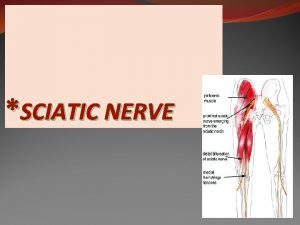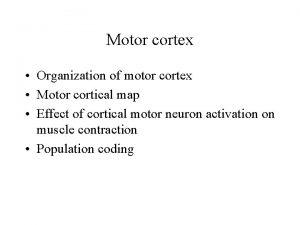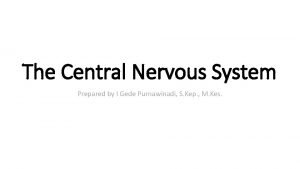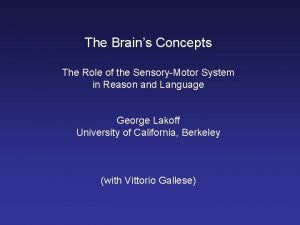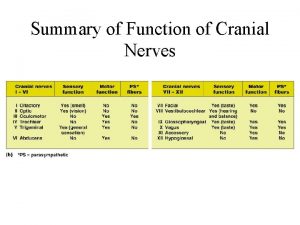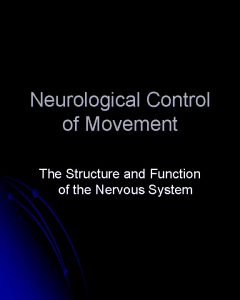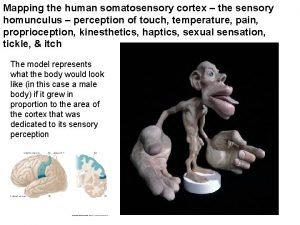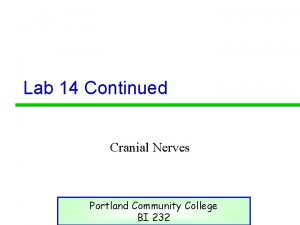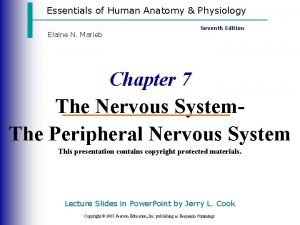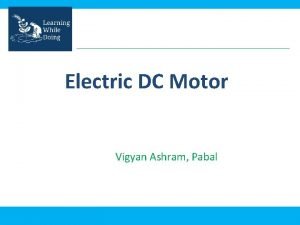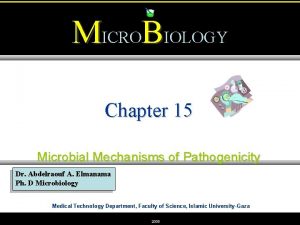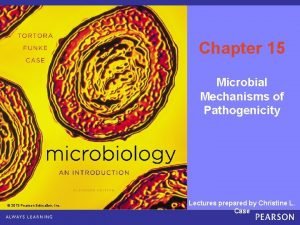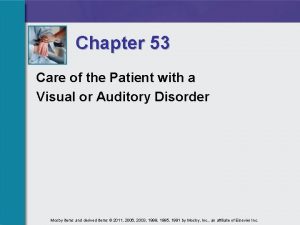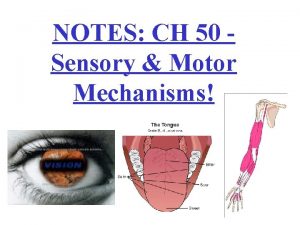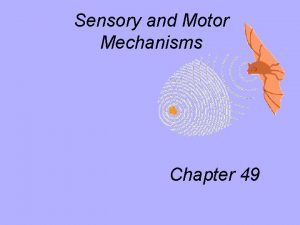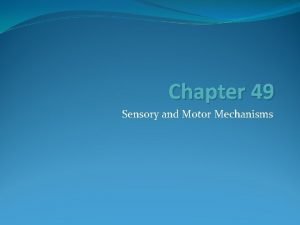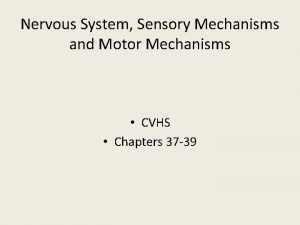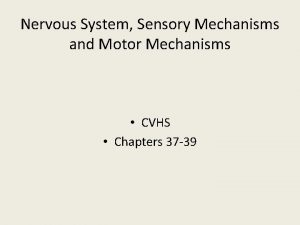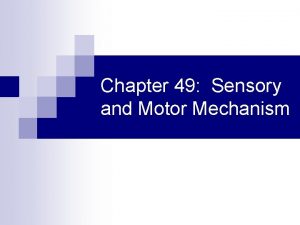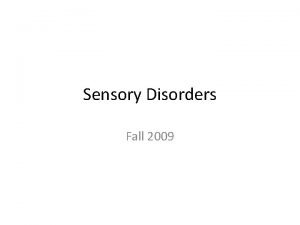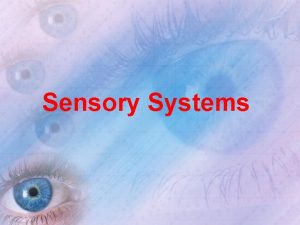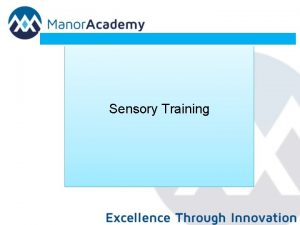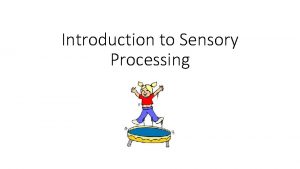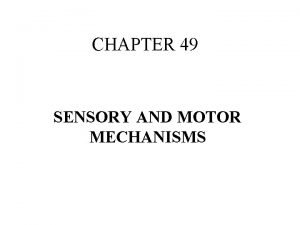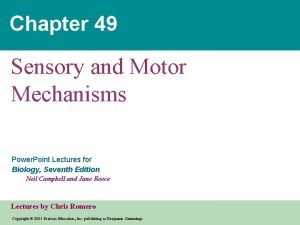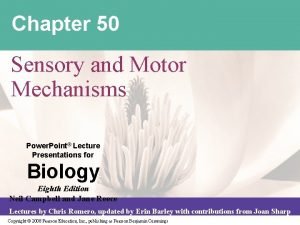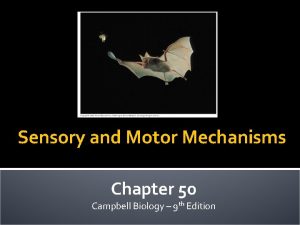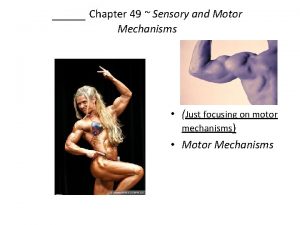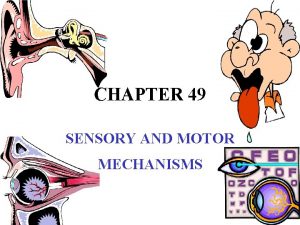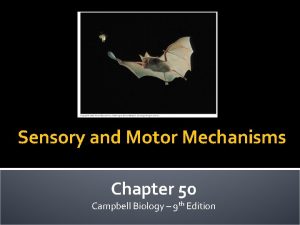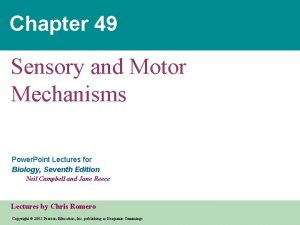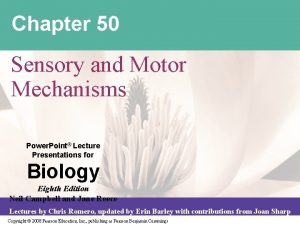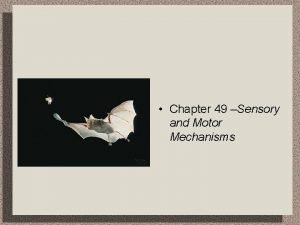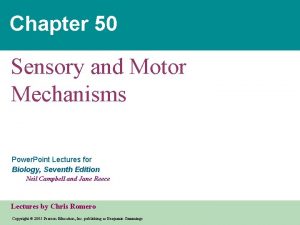Chapter 50 Sensory and Motor Mechanisms Copyright 2005




































- Slides: 36

Chapter 50 • Sensory and Motor Mechanisms Copyright © 2005 Pearson Education, Inc. publishing as Benjamin Cummings

Figure 49. 1 Copyright © 2005 Pearson Education, Inc. publishing as Benjamin Cummings

Sensory receptors • Transmit signals to CNS • Sensations are action potentials • The brain interprets (integration) perception of stimuli Copyright © 2005 Pearson Education, Inc. publishing as Benjamin Cummings

Integration • Begins as soon as the information is received • Occurs at all levels of the nervous system Copyright © 2005 Pearson Education, Inc. publishing as Benjamin Cummings

Information Processing • 3 stages – Sensory input, integration, and motor output Sensory input Integration Sensor Motor output Effector Figure 48. 3 Peripheral nervous system (PNS) Copyright © 2005 Pearson Education, Inc. publishing as Benjamin Cummings Central nervous system (CNS)

Neuron Structure Dendrites Cell body Nucleus Synapse Signal Axon direction Axon hillock Presynaptic cell Postsynaptic cell Myelin sheath Figure 48. 5 Copyright © 2005 Pearson Education, Inc. publishing as Benjamin Cummings Synaptic terminals

Action Potentials • At the site where the action potential is generated an electrical current depolarizes the neighboring region of the axon membrane Axon Action potential – – + + + + +Na + – – – – + + + + – – + – K+ + – – K+ + Action potential – + Na+ + – K+ Figure 48. 14 + + – – + + K+ + – – + + – Action potential – + Na++ + – – – + + Copyright © 2005 Pearson Education, Inc. publishing as Benjamin Cummings 1 An action potential is generated as Na+ flows inward across the membrane at one location. 2 The depolarization of the action potential spreads to the neighboring region of the membrane, re-initiating the action potential there. To the left of this region, the membrane is repolarizing as K+ flows outward. 3 The depolarization-repolarization process repeated in the next region of the membrane. In this way, local currents of ions across the plasma membrane cause the action potential to be propagated along the length of the axon. is

Conduction Speed • Increases with the diameter of an axon • Myelinated axons also faster Copyright © 2005 Pearson Education, Inc. publishing as Benjamin Cummings

• When action potential reaches a terminal release of neurotransmitters into the synaptic cleft Postsynaptic cell Presynaptic cell Synaptic vesicles containing neurotransmitter 5 Presynaptic membrane Ligandgated ion channel Ca 2+ 4 2 3 Synaptic cleft Figure 48. 17 Neurotransmitter Postsynaptic membrane Voltage-gated 1 Na+ K+ Ligand-gated ion channels Copyright © 2005 Pearson Education, Inc. publishing as Benjamin Cummings Postsynaptic membrane 6

Mechanoreceptors • sense physical deformation – e. g. pressure, stretch, motion, and sound Cold Light touch Pain Hair Heat Epidermis Dermis Nerve Copyright © 2005 Pearson Education, Inc. publishing as Benjamin Cummings Connective tissue Hair movement Strong pressure

Chemoreceptors 0. 1 mm • Transmit information about solute concentration Copyright © 2005 Pearson Education, Inc. publishing as Benjamin Cummings

Electromagnetic Receptors • Detect light, electricity, EM radiation, and magnetism Copyright © 2005 Pearson Education, Inc. publishing as Benjamin Cummings

• Many mammals use the Earth’s magnetic field lines to orient themselves as they migrate Figure 49. 5 b (b) Some migrating animals, such as these beluga whales, apparently sense Earth’s magnetic field and use the information, along with other cues, for orientation. Copyright © 2005 Pearson Education, Inc. publishing as Benjamin Cummings

Thermoreceptors • Help regulate body temperature by signaling both surface and body core temperature Copyright © 2005 Pearson Education, Inc. publishing as Benjamin Cummings

Hearing and Equilibrium in Mammals human ear 1 2 The middle ear and inner ear Overview of ear structure Incus Middle ear Inner ear Outer ear Stapes Malleus Skull bones Semicircular canals Auditory nerve, to brain Pinna Tympanic membrane Auditory canal Hair cells Cochlea Eustachian tube Tectorial membrane Tympanic membrane Oval window Eustachian tube Round window Cochlear duct Bone Vestibular canal Auditory nerve Basilar membrane Figure 49. 8 Axons of sensory neurons To auditory nerve 4 The organ of Corti Copyright © 2005 Pearson Education, Inc. publishing as Benjamin Cummings Tympanic canal 3 The cochlea Organ of Corti

Equilibrium • semicircular canals in the inner ear semicircular canals The , arranged in three spatial planes, detect angular movements of the head. Each canal has at its base a swelling called an ampulla, containing a cluster of hair cells. When the head changes its rate of rotation, inertia prevents endolymph in the semicircular canals from moving with the head, so the endolymph presses against the cupula, bending the hairs. Flow of endolymph Vestibular nerve Cupula Hairs Hair cell Nerve fibers Vestibule Utricle Body movement Saccule Figure 49. 11 The utricle and saccule tell the brain which way is up and inform it of the body’s position or linear acceleration. Copyright © 2005 Pearson Education, Inc. publishing as Benjamin Cummings The hairs of the hair cells project into a gelatinous cap called the cupula. Bending of the hairs increases the frequency of action potentials in sensory neurons in direct proportion to the amount of rotational acceleration.

Taste • Modified epithelial cells organized into taste buds • Five taste perceptions; sweet, sour, salty, bitter, and umami (elicited by glutamate) Copyright © 2005 Pearson Education, Inc. publishing as Benjamin Cummings

Smell • Olfactory receptor cells line the upper portion of the nasal cavity Brain Action potentials Odorant Olfactory bulb Nasal cavity Bone Epithelial cell Odorant receptors Chemoreceptor Plasma membrane Figure 49. 15 Odorant Copyright © 2005 Pearson Education, Inc. publishing as Benjamin Cummings Cilia Mucus

Vision • Most invertebrates have some sort of lightdetecting organ Light shining from the front is detected Photoreceptor Visual pigment Ocellus Nerve to brain Screening pigment Light shining from behind is blocked by the screening pigment Copyright © 2005 Pearson Education, Inc. publishing as Benjamin Cummings

• 2 types of image-forming eyes have evolved in invertebrates – compound eye and the single-lens eye Copyright © 2005 Pearson Education, Inc. publishing as Benjamin Cummings

• Vertebrate eye Sclera Choroid Retina Ciliary body Fovea (center of visual field) Suspensory ligament Cornea Iris Optic nerve Pupil Aqueous humor Lens Vitreous humor Central artery and vein of the retina Figure 49. 18 Copyright © 2005 Pearson Education, Inc. publishing as Benjamin Cummings Optic disk (blind spot)

• Retina contains two types of photoreceptors – Rods, sensitive to light but do not distinguish colors – Cones, distinguish colors but are not as sensitive Copyright © 2005 Pearson Education, Inc. publishing as Benjamin Cummings

Animal skeletons • Support, protection, and movement • Movement results from muscles working against some type of skeleton Copyright © 2005 Pearson Education, Inc. publishing as Benjamin Cummings

Exoskeletons • e. g. Molluscs and arthropods Copyright © 2005 Pearson Education, Inc. publishing as Benjamin Cummings

Endoskeletons • Sponges, echinoderms, and chordates Copyright © 2005 Pearson Education, Inc. publishing as Benjamin Cummings

• Muscles move skeletal parts by contracting Copyright © 2005 Pearson Education, Inc. publishing as Benjamin Cummings

Vertebrate Skeletal Muscle • hierarchy of smaller and smaller units Muscle Bundle of muscle fibers Nuclei Single muscle fiber (cell) Plasma membrane Myofibril Z line Light band Dark band Sarcomere TEM I band 0. 5 m A band I band M line Thick filaments (myosin) Figure 49. 28 Thin filaments (actin) Copyright © 2005 Pearson Education, Inc. publishing as Benjamin Cummings Z line H zone Sarcomere Z line

• Myofibrils are composed to 2 kinds of myofilaments – Thin filaments, consisting of actin – Thick filaments, arrays of myosin molecules Copyright © 2005 Pearson Education, Inc. publishing as Benjamin Cummings

• Skeletal muscle is striated Copyright © 2005 Pearson Education, Inc. publishing as Benjamin Cummings

• The Sliding-Filament Model of Muscle Contraction (a) Relaxed muscle fiber. In a relaxed muscle fiber, the I bands and H zone are relatively wide. Z H A Sarcomere (b) Contracting muscle fiber. During contraction, the thick and thin filaments slide past each other, reducing the width of the I bands and H zone and shortening the sarcomere. (c) Fully contracted muscle fiber. In a fully contracted muscle fiber, the sarcomere is shorter still. The thin filaments overlap, eliminating the H zone. The I bands disappear as the ends of the thick filaments contact the Z lines. Figure 49. 29 a–c Copyright © 2005 Pearson Education, Inc. publishing as Benjamin Cummings 0. 5 m

• Myosin-actin interactions underlying muscle fiber contraction Thick filament 1 Starting here, the myosin head is bound to ATP and is in its lowenergy confinguration. Thin filaments 5 Binding of a new molecule of ATP releases the myosin head from actin, and a new cycle begins. Thin filament Myosin head (low- ATP Thick filament Thin filament moves toward center of sarcomere. Figure 49. 30 + Pi Cross-bridge binding site Actin ADP Myosin head (lowenergy configuration) ADP 2 The myosin head hydrolyzes ATP to ADP and inorganic phosphate ( P I ) and is in its high-energy configuration. energy configuration) ATP Pi ADP 4 Releasing ADP and ( P i), myosin relaxes to its low-energy configuration, sliding the thin filament. Copyright © 2005 Pearson Education, Inc. publishing as Benjamin Cummings Pi Cross-bridge Myosin head (highenergy configuration) 13 The myosin head binds to actin, forming a crossbridge.

The Role of Calcium and Regulatory Proteins • When a muscle is at rest – The myosin-binding sites on the thin filament are blocked by the regulatory protein tropomyosin Tropomyosin Actin Figure 49. 31 a Ca 2+-binding sites (a) Myosin-binding sites blocked Copyright © 2005 Pearson Education, Inc. publishing as Benjamin Cummings Troponin complex

• For a muscle fiber to contract – The myosin-binding sites must be uncovered • This occurs when calcium ions (Ca 2+) – Bind to another set of regulatory proteins, the troponin complex Ca 2+ Myosinbinding site Figure 49. 31 b (b) Myosin-binding sites exposed Copyright © 2005 Pearson Education, Inc. publishing as Benjamin Cummings

• Stimulus leading to the contraction of muscle fiber is an action potential in a motor neuron Motor neuron axon Mitochondrion Synaptic terminal T tubule Sarcoplasmic reticulum Myofibril Figure 49. 32 Plasma membrane of muscle fiber Copyright © 2005 Pearson Education, Inc. publishing as Benjamin Cummings Ca 2+ released from sarcoplasmic reticulum Sarcomere

Review Synaptic terminal of motor neuron 1 PLASMA MEMBRANE T TUBULE Synaptic cleft Acetylcholine ( ACh SR 2 Action potential Ca 2 3 Action potential triggers Ca 2+ release from sarcoplasmic reticulum (SR). 7 Tropomyosin blockage 4 Ca 2 CYTOSOL ADP 6 P 2 Calcium ions bind Cytosolic Ca 2+ is removed by active transport into SR after action potential ends. 5 Myosin cross-bridges Figure 49. 33 Copyright © 2005 Pearson Education, Inc. publishing as Benjamin Cummings

Other Types of Muscle • Cardiac muscle, striated cells electrically connected by intercalated discs – Can generate action potentials without neural input • Smooth muscle, contractions slow and may be caused by stimulation from autonomic nervous system Copyright © 2005 Pearson Education, Inc. publishing as Benjamin Cummings
 Tissue
Tissue Cranial cavity anatomy
Cranial cavity anatomy Depolarization
Depolarization Cranial nerves sensory and motor
Cranial nerves sensory and motor Fundamentals of the nervous system and nervous tissue
Fundamentals of the nervous system and nervous tissue Motor and sensory cranial nerves
Motor and sensory cranial nerves Motor and sensory nerve
Motor and sensory nerve Incoming sensory impulses and outgoing motor impulses
Incoming sensory impulses and outgoing motor impulses Pearson education inc publishing
Pearson education inc publishing Copyright 2005
Copyright 2005 2005 pearson prentice hall inc
2005 pearson prentice hall inc Copyright 2005
Copyright 2005 Copyright 2005
Copyright 2005 Copyright 2005
Copyright 2005 Copyright 2005
Copyright 2005 Pearson
Pearson Copyright 2005
Copyright 2005 Copyright 2005
Copyright 2005 Sciatic nerve sensation
Sciatic nerve sensation Cn i
Cn i Motor cortex sensory cortex
Motor cortex sensory cortex Sensory vs motor homunculus
Sensory vs motor homunculus Sensory-motor
Sensory-motor Sensory cranial nerves
Sensory cranial nerves Saltitory
Saltitory What is a homunculus
What is a homunculus How to check oculomotor nerve
How to check oculomotor nerve Old opie occasionally tries
Old opie occasionally tries What is a motor unit
What is a motor unit Three phase synchronous generator
Three phase synchronous generator Use of synchronous motor
Use of synchronous motor Motor parts name
Motor parts name Ee 216
Ee 216 Chapter 15 microbial mechanisms of pathogenicity
Chapter 15 microbial mechanisms of pathogenicity Pearson
Pearson Chapter 53 care of the patient with a sensory disorder
Chapter 53 care of the patient with a sensory disorder Sensory evaluation cryptogram answers
Sensory evaluation cryptogram answers
